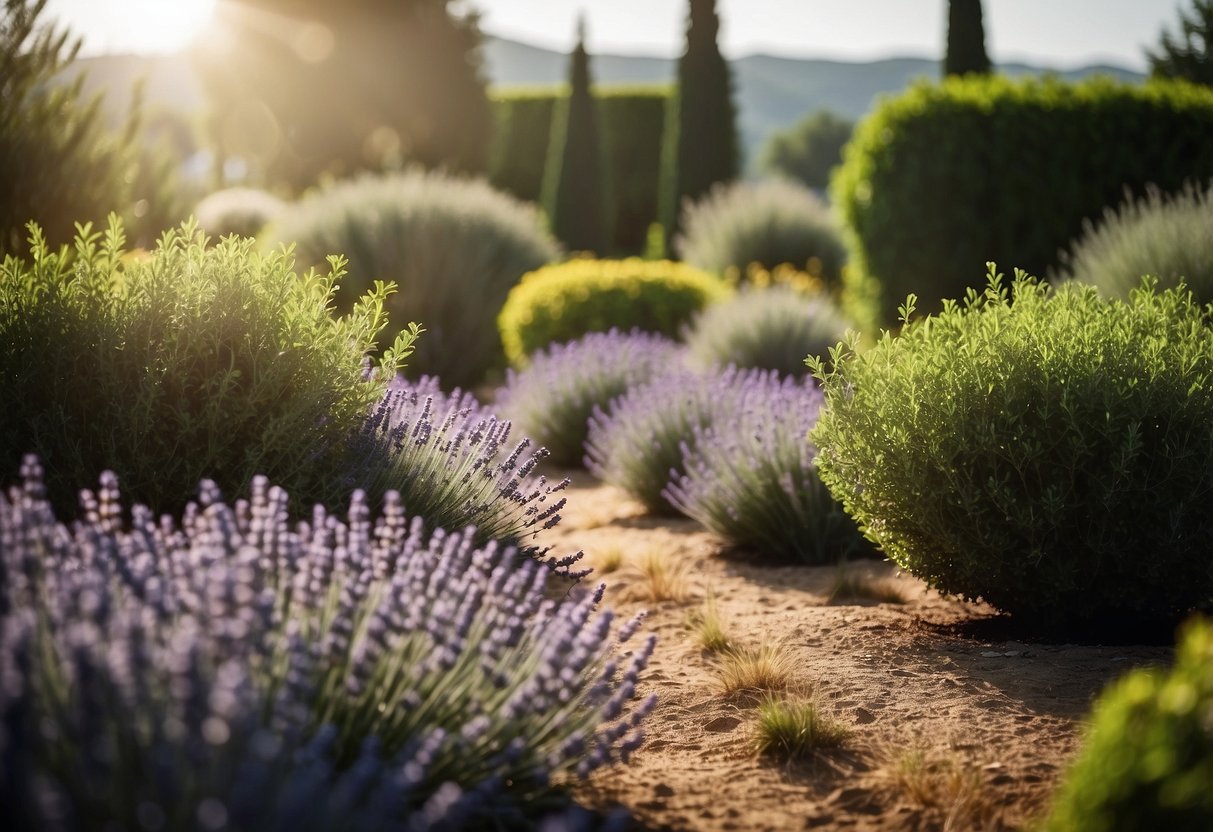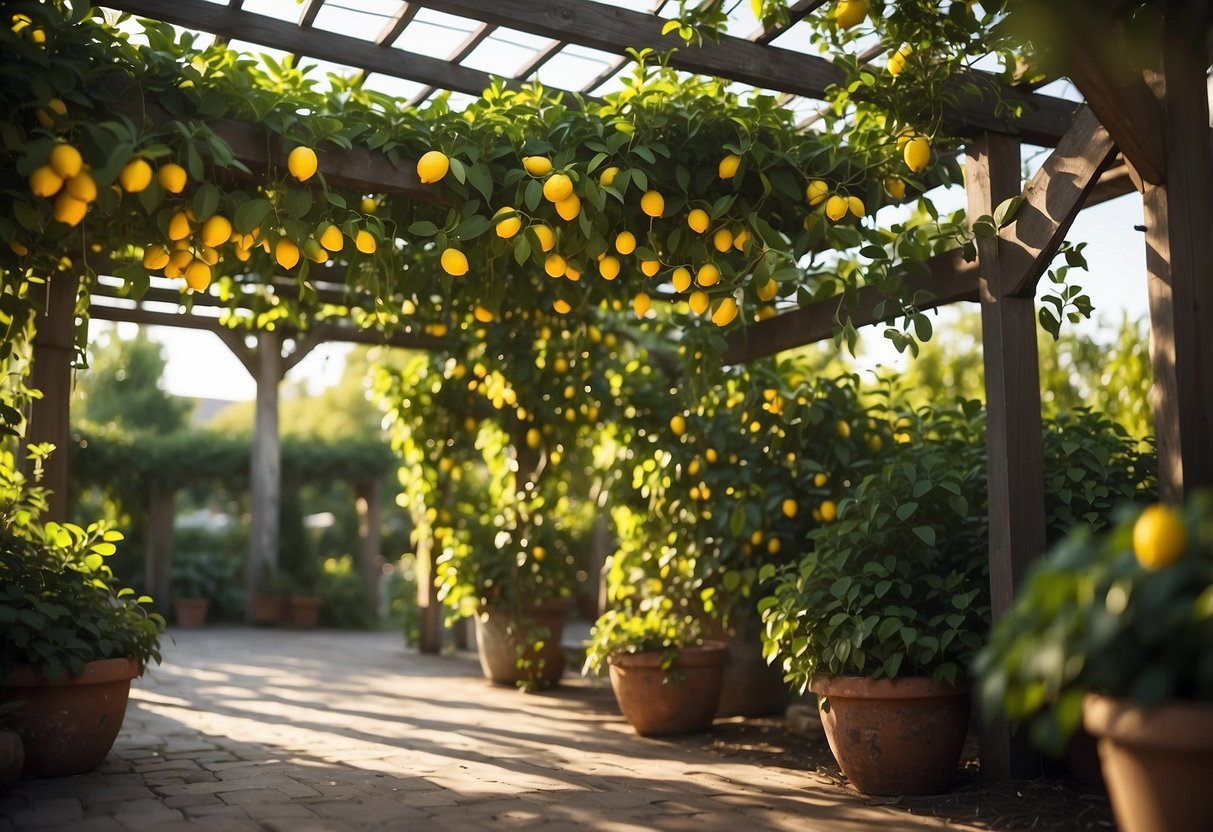Lemon Tree Garden Ideas: Brighten Your Outdoor Space
Lemon trees add a touch of beauty and practicality to any garden. With their glossy green leaves and fragrant flowers, they not only enhance the landscape but also provide fresh lemons right at your doorstep. Whether you have a large yard or limited space, there are many ways to incorporate lemon trees into your garden.

Are you wondering how to make the most of your garden space with lemon trees? From planting them in containers to designing a focal point for your outdoor area, lemon trees offer versatile options. This article will explore different ideas to help you create a lovely lemon tree garden that fits your space and needs.
1) Create a Lemon Tree Archway

Creating a lemon tree archway in your garden can be a fun and rewarding project. Start by choosing two sturdy lemon trees that are suitable for your climate.
Plant the trees close enough so their branches can meet above your walkway.
Train the branches to grow over a support structure, like an arch or trellis.
Use ties or soft twine to gently guide the branches across the arch.
Keep the soil evenly moist and ensure the roots have good drainage.
With care and patience, you’ll have a beautiful lemon tree archway that adds charm to your garden.
2) Install a Lemon-Themed Garden Path

Consider using yellow bricks or stones to create a path that echoes the bright color of lemons. This cheerful walkway can lead guests through your garden, adding a pop of color.
You can also add lemon-shaped stepping stones. These quirky elements fit well into the theme and add a fun touch to your garden.
Incorporate potted lemon trees along the path. Not only do they look good, but they also add a refreshing lemon scent as you walk by.
3) Add a Lemon Tree Border

Imagine lining your garden path with beautiful lemon trees. This can create a stunning, fragrant border.
Plant the trees about 10-15 feet apart to ensure they have enough space. This spacing also helps with air circulation, which keeps the trees healthy.
Lemon trees have dense canopies and glossy green leaves. They add a touch of evergreen beauty to your garden year-round.
4) Use Lemon Trees in Potted Arrangements

Lemon trees in pots can make your garden look beautiful and fresh. They are easy to move around and perfect for small spaces.
Place your potted lemon tree in a sunny spot. They love sunlight and need it to grow well. Make sure the pot has good drainage.
Use a liquid fertilizer formulated for citrus every 3-4 weeks for the best results. This will help your tree stay healthy and bear fruit.
5) Combine Lemon Trees with Lavender

You can plant lavender near your lemon trees to create a beautiful and practical garden. Lavender attracts beneficial insects that help control pests on lemon trees.
Lavender’s aromatic properties can also deter unwanted pests. Plus, it adds lovely purple blooms and soothing scents to your garden space, making it both functional and visually appealing.
Consider planting lavender in a sunny spot with well-drained soil around your lemon trees. This combination promotes a healthier garden ecosystem and enhances your outdoor space. For more details, check out this guide on companion plants for lemon trees.
6) Incorporate Lemon Trees in a Pergola

You can create a refreshing outdoor space by adding lemon trees to your pergola. This not only provides shade but also brings a pop of color with the vibrant yellow lemons.
Make sure to plant the trees in large pots to easily move them as needed. Water them regularly, as suggested in this guide.
To add a touch of beauty, consider using fairy lights intertwined with the pergola and trees. This will create a magical setting, especially in the evenings.
7) Design a Lemon Tree Seating Area

Creating a seating area near your lemon tree can be a peaceful retreat in your garden. Place a comfortable bench or a set of chairs around your lemon tree. The shade from the tree will provide a cool spot to relax.
Add some potted lemon trees to enhance the space. This can create a cozy and inviting atmosphere. Consider adding a small table for holding drinks or a book. Enjoy the fresh scent and beauty of the lemon tree while you unwind.
8) Plant Lemon Trees Along a Fence

Planting lemon trees along a fence can be a great way to save space in your garden. The fence provides support and acts as a windbreak, protecting the trees from strong gusts.
Keep your lemon trees at least a few feet away from the fence to allow for growth and airflow. This will help prevent diseases and ensure your trees get enough sunlight.
Water the trees regularly and mulch around the base to retain moisture. You may want to consider companion planting with herbs like basil or dill to enhance the health of your lemon trees. For more tips, visit 12 Best Companion Plants for Lemon Trees.
9) Create a Lemon Tree and Herb Garden

Planting a lemon tree with herbs is fantastic for your garden. Herbs like lemon basil and lavender are great choices. Lemon basil grows about 18 inches tall and has small, flavorful leaves. Lavender not only smells wonderful but also deters pests from your lemon tree.
Place herbs like African daisies a bit away from the lemon tree roots, within a few meters. This attracts bees, which help with pollination.
Herbs like Plectranthus can add more beauty and help attract beneficial insects. With these simple additions, your lemon tree and herb garden will thrive.
10) Add Fairy Lights to Lemon Trees

Fairy lights can make your lemon tree garden look magical. Wrap the lights around the trunk and branches for a beautiful glow. This adds a cozy touch, especially in the evening.
Choose waterproof lights to handle outdoor conditions. Battery-operated or solar-powered options work well and are easy to set up.
For a more whimsical effect, try dangling fairy lights from the branches. This creates a dreamy atmosphere, perfect for garden parties or quiet nights outside.
Choosing the Right Lemon Tree

Picking the perfect lemon tree for your garden involves considering the size of the variety and the climate of your region. These factors ensure your tree thrives and produces healthy, delicious lemons.
Dwarf vs. Standard Varieties
When it comes to lemon trees, size matters. Dwarf lemon trees are great if you have limited space or want to grow lemons in containers.
Dwarf varieties typically reach about 8 to 10 feet tall, making them easy to manage and harvest. They are ideal for indoor growing or small gardens.
Standard lemon trees, on the other hand, can grow up to 20 feet tall. These trees are perfect if you have a larger outdoor space. They produce more fruit than dwarf trees and can create a striking presence in your garden.
Both varieties need well-drained soil and lots of sunlight. Choose a tree based on how much space you have and how much fruit you want. Consider starting with a variety that is easier to grow and maintain.
Climate Considerations
Your climate plays a crucial role in the success of your lemon tree. Lemon trees flourish in warm climates, specifically in USDA growing zones 9-11. In these zones, the temperature ranges from 55 to 70 degrees Fahrenheit, which is perfect for lemon trees.
In colder climates, you can still grow lemon trees in containers. This way, you can move them indoors during winter to protect them from frost. For those in chilly areas, choose cold-hardy varieties like the Meyer lemon, which can tolerate lower temperatures better than other types.
It’s important to protect lemon trees from frost and ensure they get enough sunlight. Keeping an eye on the weather and moving your tree when necessary can help it thrive despite the cold.
Planting and Soil Preparation

To plant a lemon tree and get it growing well, you need the right soil and some good planting tips. Choosing the best soil and knowing how to plant it will set your lemon tree up for success.
Ideal Soil Conditions
Lemon trees thrive in loose, sandy, and slightly acidic soil. The pH should be between 5.5 and 6.5. You can test your soil’s pH using a home testing kit. If the pH is too high, adding sulfur can help lower it.
Drainage is key. Lemon trees don’t like wet feet, so make sure your soil drains well. You can improve drainage by adding compost or sand. Nutrient-rich soil is also crucial for strong growth. Mix in some well-rotted manure or a slow-release fertilizer to give your lemon tree a nutrient boost.
Regularly check the soil moisture. Keep it moist but not soggy. Use a moisture meter or test it with your finger. This will keep the roots from rotting and ensure a healthy tree.
Planting Tips for Success
Choose a sunny spot for planting your lemon tree. It needs at least 6-8 hours of sunlight daily. Spring is the best time to plant, as it gives the tree plenty of time to establish before winter.
Dig a hole that is twice as wide and just as deep as the root ball. Place the tree in the hole, making sure the top of the root ball is level with the ground. Fill the hole with soil, and gently pack it down.
Water thoroughly after planting. This helps settle the soil and remove air pockets. Spread a 2-4 inch layer of mulch around the base, keeping it away from the trunk to prevent moisture buildup.
By following these tips, your lemon tree will have a great start and a strong foundation for healthy growth.
Caring for Your Lemon Tree

Proper care for your lemon tree involves watering, fertilizing, and combating diseases and pests. These steps ensure that your tree stays healthy and productive.
Watering Guidelines
Watering is essential for maintaining your lemon tree’s health. Newly planted trees should be watered deeply to ensure the soil around the root ball is sufficiently moist. Place mulch over the soil-covered root ball to help retain moisture.
For outdoor lemon trees, deep watering once a week is enough. Lemon trees need plenty of water but make sure they don’t become water-logged. Indoor lemon trees should be watered every 10 to 14 days. Always let the top inch of soil dry out before watering again.
Fertilization Techniques
Using the right fertilizer is crucial for your lemon tree’s growth. Choose a citrus-specific fertilizer and only apply it to the top of the soil. Do not mix it into the soil.
Apply fertilizer during the active-growing months of spring and summer. A slow-release fertilizer works best, releasing nutrients over time to ensure steady growth. Remember to follow the package instructions to avoid over-fertilizing, which can harm the tree.
Disease and Pest Management
Keeping an eye on diseases and pests helps keep your tree healthy. Common pests like aphids, spider mites, and scale insects can be controlled with insecticidal soaps or neem oil. Regularly inspect the leaves and branches for any signs of infestation.
Fungal diseases can be prevented by ensuring good air circulation around the tree and avoiding overhead watering. If you spot any signs of disease, such as yellowing leaves or black spots, treat your tree with a fungicide. Regular pruning also helps by removing diseased or dead branches, promoting better tree health.
By following these guidelines, you’ll be well on your way to a thriving lemon tree in your garden.







